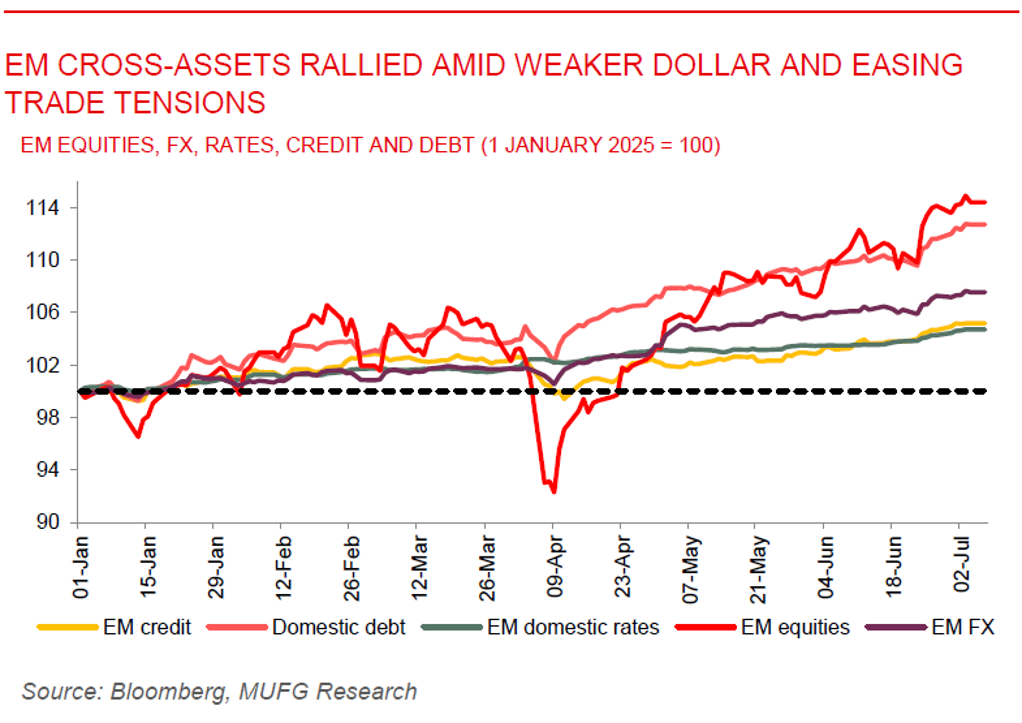To read the full report, please download the PDF above.
Middle East Daily
SOOJIN KIM
Research Analyst
DIFC Branch – Dubai
T: +44(4)387 5031
E: soojin.kim@ae.mufg.jp
MUFG Bank, Ltd. and MUFG Securities plc
A member of MUFG, a global financial group
Middle East Daily
COMMODITIES / ENERGY
OPEC+ approves largest supply hike as oil faces oversupply and trade uncertainty. Oil prices extended losses after OPEC+ approves a larger than expected supply increase of 548,000b/d for August, accelerating the rollback of previous output cuts and raising fresh concerns about oversupply. Brent dropped as much as 1.6% to near USD67/b, while WTI traded around USD66/b, as traders reacted to the alliance’s decision to fast-track production hikes just as global demand faces mounting headwinds from rising tariffs and macro uncertainty. OPEC+ cited strong summer demand and stable market fundamentals to justify the move, signalling confidence that the additional barrels can be absorbed, with plans to revisit another potential hike of the same size in September. However, investors remain cautious, especially as seasonal demand typically softens later in the year and US trade tensions intensify. President Trump’s upcoming tariffs, including a fresh threat targeting BRICS-aligned nations, added to the markets cautious tone. The move marks a sharp shift from OPEC+’s past restraint, with another similar hike under consideration for September.
Gold slips as BRICS tariff threat lifts dollar. Gold declined as much as 0.9% to near USD3,306/oz after President Trump signalled a 10% tariff on countries aligned with BRICS, boosting the dollar and weighting on gold. While ongoing US trade negotiations ahead of 9 July deadline have introduced some uncertainty, Treasury and Commerce officials hinted at potential extensions and staggered tariff implementation starting 1 August. Despite the pullback, gold remains up over 25% YTD, supported by haven demand amid global tensions, ETF flows, and robust central bank buying.
MIDDLE EAST - CREDIT TRADING
End of day comment – 04 July 2025. No trading desk commentary was circulated due to the US independence day holiday.
MIDDLE EAST - MACRO / MARKETS
EM debt issuance surges amid strong Gulf activity and diversification trends. EM debt issuance surged in the first half of 2025, defying global volatility and signalling growing investor confidence, with Gulf issuers leading the charge. Total EM bond sales surpassed USD190bn and are on pace to exceed 2024’s record of USD285bn. The Middle East, spearheaded by Saudi Arabia, accounted for over 40% of CEEMEA issuance, raising USD106bn in just six months, already nearing last year’s full-year total of USD139bn. Strong appetite from yield-seeking, cash-rich investors drove robust sovereign and corporate issuance, including debut bonds from new EM names like Saudi Arabia’s Maaden and Angola’s Azul energy. A notable shift toward non-USD financing emerged, with Saudi Arabia and Sharjah issuing in euros, and other borrowers exploring yen, yuan, and Swiss franc markets, early signs of de-dollarisation. Additionally, the region responded to rising global rates by favouring shorter three-year maturities over traditional 30-year tenors. Overall, the EM debt landscape is proving resilient and adaptive, with the Gulf at the forefront of record borrowing, growing issuer diversity, and strategic funding shifts.
Egypt’s non-oil sector weakens further in June. Egypt’s non-oil private sector experiences a continued downturn as PMI fell to 48.8 from 49.5 in May, remaining below the neutral 50.0 mark for the fourth consecutive month. The decline reflected sharper contractions in output and new orders, driven by weak client demand and a stagnating local market environment. In response, businesses implemented the steepest reduction in purchasing activity in nearly a year and scaled back staffing levels for the fifth month running, though the pact of job cuts was marginal. Business sentiment deteriorated further, reaching its lowest level on record, as firms expressed deep concerns about future demand and potential geopolitical disruptions. Despite the gloomy outlook, there were some positive signs, including a moderation in both input cost and output price inflation, suggesting that pressure on margins may be easing slightly. Nonetheless, the overall picture remained one of subdued economic activity and cautious business behaviour heading into the second half of the year.

